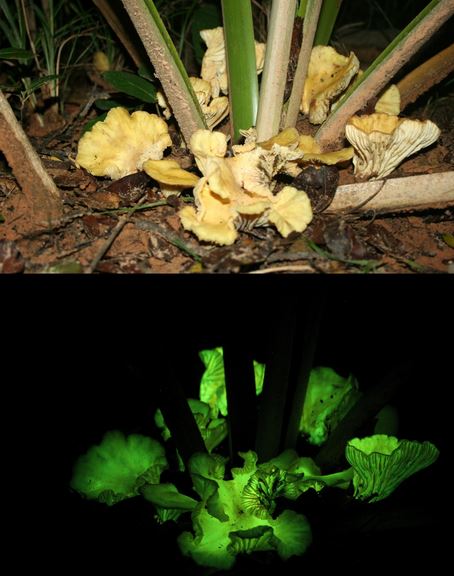For over 2,000 years, since Aristotle posed the question, we have been wondering why some mushrooms glow in the dark. Researchers from Brazil’s Instituto de Química-Universidade de São Paulo and Dartmouth’s Geisel School of Medicine say it’s to attract insects, including ants, wasps, flies and beetles.
The mushrooms want the insects to come because they spread their fungal spores around.
The findings of this latest study were published in the Cell Press academic journal Current Biology (citation below).
Author Cassius Stevani explained that the mushrooms’ bioluminescence (light emitted by organisms) is driven by its Circadian clock. The Circadian clock or Circadian rhythm refers to an animal’s or plant’s ‘internal body clock’ that regulates the 24 hour cycle of biological processes.

N. gardneri mushrooms growing on the base of a young babassu palm in Gilbués, PI, Brazil. (Image Credit: Michele P. Verderane/IP-USP-2008)
The researchers explained that it was, in fact, the mushroom’s Circadian clock discovery that lead them to wonder whether the glowing effect might serve some useful purpose.
Jay Dunlap of Dartmouth’s Geisel School of Medicine in New Hampshire said “Regulation implies an adaptive function for bioluminescence.”
Insects help the mushroom colonize new habitats
Mr. Stevani said:
“It appears that fungi make light so they are noticed by insects who can help the fungus colonize new habitats.”
Controlling the bioluminescence through Circadian control makes the process more efficient.
There are several examples of biological organisms generating light in a variety of ways. Among them, fungi are the rarest and least well understood.
Of the more than 100,000 fungal species we know exist, only 71 produce green light through a biological process that requires energy and oxygen.
Scientists had thought that fungi, in most cases, produced light around the clock, believing it was a simple metabolic byproduct.
Stevani’s and Dunlap’s study suggests that this is not so, at least not in the case of Neonothopanus gardneri, one of the largest and brightest-glowing mushrooms.
N. gardneri is also known as ‘Flor de Coco’ (coconut flower) in Brazil where it can be found stuck to leaves at the base of young palm trees in coconut forests.

Mycena lux-coeli, a type of green glowing mushroom. 71 of the more than 100,000 fungal species described glow in the dark.
Glows only when it’s easy to see
Dunlap and Stevani found that N. gardneri’s glow is controlled by a temperature-compensated circadian clock. They believe that this level of control probably helps the mushroom conserve energy by glowing only when it is easy to see.
To find what function the green glow might serve for the mushrooms, the scientists made sticky, imitation mushrooms out of acrylic resin and placed green LED lights inside some of them.
They then placed them in the forest where real glowing mushrooms are found and discovered that the glowing fake mushrooms attracted many more staphilinid rove beetles, as well as ants, wasps, and flies than the fake ones with no green light inside.
Dunlap said they would like to identify the genes responsible for the mushrooms’ glow, and to explore their interaction with the Circadian clock that controls them.
They are also observing the interaction between N. gardneri mushrooms and arthropods, especially larger ones, more closely by using infrared cameras. Arthropods are invertebrate animals that have an exoskeleton, a segmented body, and jointed appendages, such as spiders, scorpions, ticks, mites, centipedes, lobsters, crabs, shrimp, crayfish, krill and barnacles.
The authors say their findings are not only ‘cool’, but also useful in understanding how mushrooms are dispersed in the environment. Mushrooms such as N. gardneri are important contributors to a forest’s ecosystem.
Stevani said:
“Without them, cellulose would be stuck in its form, which would impact the whole carbon cycle on Earth. I dare to say that life on Earth depends on organisms like these.”
Some fungi in the basidiomycetes group, including two bioluminescent ones, are also parasites of pine trees and coffee plants. Stevani said “it is very important to know how basidiomycetes grow and consequently how they spread their spores.”
The study was funded by grants from the Fundação de Amparo à Pesquisa do Estado de São Paulo and the National Institute of General Medical Sciences of the NIH.
Citation: “Circadian Control Sheds Light on Fungal Bioluminescence,” Anderson G. Oliveira, Cassius V. Stevani, Hans E. Waldenmaier, Vadim Viviani, Jillian M. Emerson, Jennifer J. Loros and Jay C. Dunlap. Current Biology. DOI: 10.1016/j.cub.2015.02.021.
